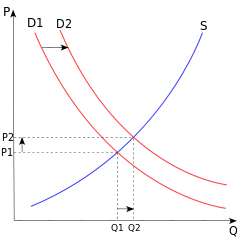Keynesian economics is the use of fiscal policies (government spending and taxes) as a means to control the economy. This idea was adopted by the British economist John Maynard Keynes, one of the most important thinkers of the 20th century. Keynes's ideas shaped the modern world economy. Keynes is still respected and followed.
Keynes's masterpiece The General Theory (General Theory of Employment, Interest and Money) published in 1936 was written in response to the Great Depression. He argued that the government had a mission that they had previously ignored. This task was to keep the economy alive during trauma. The book was written to criticize the idea that the French Jean-Baptiste Say (1767-1832) would "each supply creates his own demand". According to Say's idea, in the economy as a whole, the production of goods was enough to create demand on its own.
Revitalizing the economy
Up to the Great Depression, the assumption was that the economy was largely self-regulating. The invisible hand left to itself will bring employment and economic efficiency to the optimum level. Keynes strongly opposes it. In periods of economic downturn, defend the claim that reducing the demand will cause the economy to shrink with a serious crisis and increase unemployment. The government's task is to revive the economy. The government can do this by borrowing money and creating employment in the neighborhood sector, increasing cash in infrastructure projects (eg roads, railways, hospitals and school buildings). Decrease in interest rates may not be enough, but it may stimulate the economy a bit.
According to Keynes, the extra expenditures the government will make are spread throughout the economy. For example, a new highway construction creates jobs for construction companies. That company's employees spend money on food, products and services, which hinders the economy from entering the crisis. The key in Keynes's argument is the idea of multiplying.
Let's say the American government has ordered a $ 10 billion plane ship to shipbuilding company Northop Grumman. We can think that the effect of this is the transfer of 10 billion dollars to the economy. However, according to the multiplying argument, the effect will be much larger. Northop Grumman will hire more people, make more profit, and spend workers' money on consumer goods. Total economic efficiency will increase much more than the initial money, depending on the "consumer tendency" of an average consumer.
If 10 billion dollars increased the American economic efficiency by 5 billion dollars, the multiplier is 0.5. If it has increased 15 billion dollars, it is 1.5.
Six Key Principles of the Keyneysen Economy
According to former presidential adviser Alan Blinder, six key principles lay behind Keynesianism. These:
- Keynesists argue that the economy is influenced by both institutional and private sector decisions and that it sometimes behaves unevenly.
- The short term is sometimes more important than the long term. Short-term increases in unemployment can lead to more damage in the long run, because it can cause permanent damage to the economy. It reminds us of the words of Keynes' famous' 'We will all die in the long run.' '
- Wages, and in particular salaries, respond very slowly to changes in supply and demand. This means that unemployment is generally higher or lower than the economy's power.
- Unemployment is usually very high and varied; recessions and crises are not an effective market reaction to unpleasant opportunities like invisible hand dictation, but rather economic disease.
- Governments must actively stabilize the natural spikes and falls in the economy.
- Keynesians tend to struggle with unemployment and give more importance to struggle with inflation.
Is the Keynesian Theory a Controversial Theory?
Keynesianism has always created controversy. Critics of it ask why we should assume that governments will better govern the economy. Is economic variability really dangerous? despite all these criticisms, the Great Depression of the 1930s was overcome by the ideas of Keynes. Franklin D. Roosevelt's program, known as the New Order, was presented as a reaction against the Krzysztyn and was a classic example of the government's spending billions in the recession to encourage the economy. It is still debated whether these policies or the Second World War ended the Great Horn. But the message from history is that government spending is working.
After the publication of the General Theory, governments around the world have greatly increased their spending. It is based on social reasons, such as improving the welfare state that will overcome the consequences of high unemployment, and Keynesianism, which emphasizes that governments should control the economy.
These interventions have worked for a long time, inflation and unemployment have declined considerably, and the economy has grown. But in the 1970s monetarists (monetarists) began criticizing Keynesian politics. One of the main arguments was that governments that implement fiscal and monetary policies on a regular basis to increase employment would not be able to fine-tune the economy. The time between the moment of realizing that there is a need for such a policy (eg tax reduction) and the effect of politics is very long. Even if the politicians problem is quickly identified, it takes time for the regulations to be written and approved. It takes longer for the tax cut to affect the entire economy. When the tax cuts finally start to work, the problem to be solved may already be worsened or destroyed.
Look at the business, Keynes came back after the 2008 crisis. Economics argues that governments should borrow and cut taxes by spending, when it is understood that the discounts on interest can not prevent the recession in America, the UK and other countries. At the end, these policies have been implemented, breaking away from the economic policies of the past twenty-five years. Despite everything, Keynes is back.
